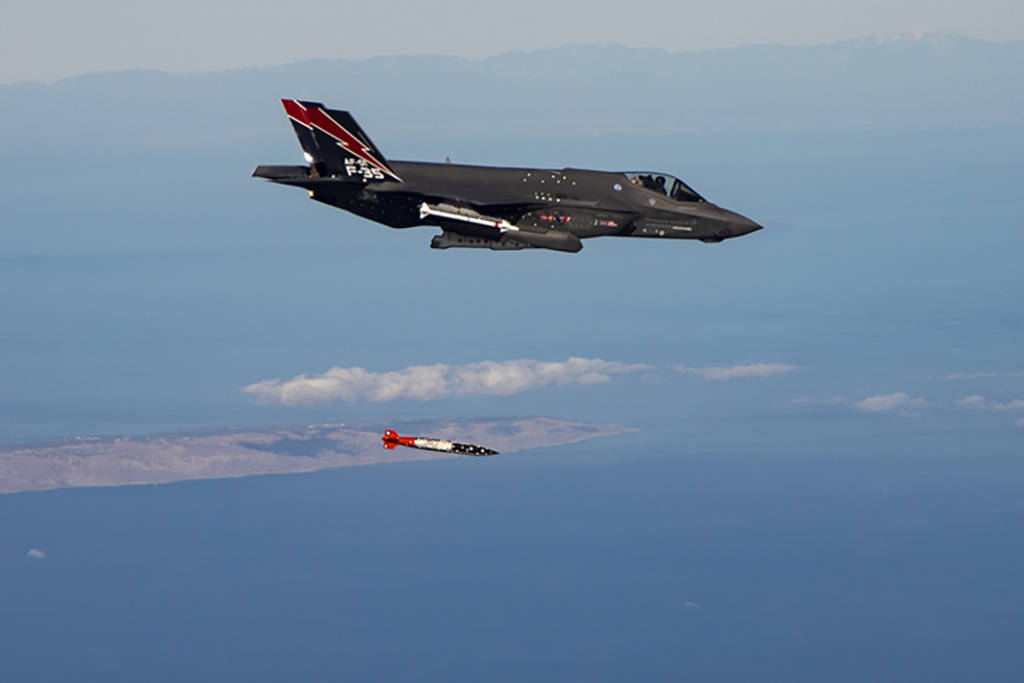On April 3, the Federation of American Scientists (FAS) published a report that included a photo of a United States’ nuclear bomb housed at a Dutch air base that appeared to have been damaged.
The report raised concerns among American scientists regarding a potential nuclear weapons-related incident at the Volkel air force base in the Netherlands.
The bomb visible in the photo is identified as a B61 bomb. It seems to be undergoing examination for potential damages by American soldiers, including two from an explosive ordnance disposal squad and a civilian.
Based on the image, the rear of the bomb seems to have been twisted due to an impact, and one of the tail fins is absent. A pink adhesive tape is placed over what appears to be a hole.
The report mentioned that the image was displayed during a presentation intended for student job applicants at the Los Alamos National Laboratory, a nuclear weapons facility in New Mexico.

The image was geolocated to the Volkel air force base in the Netherlands. This site is one of the six bases in five European countries where 100 B61 nuclear gravity bombs are stored as part of a nuclear-sharing agreement with the United States.
Initially, the US Air Force and Los Alamos National Laboratory did not comment on the photograph. However, the Pentagon later clarified that it was a mock weapon used in a training exercise.
Pentagon spokesperson Oscar Seára said, “At every military facility, we have a response team that has to train together. That is what this was; the photo was put in a recruitment manual.”
The spokesperson for the US Air Force in Europe refrained from making any direct comments regarding the photograph.
However, the spokesperson mentioned that the United States strictly adheres to the highest standards for personnel and equipment involved in supporting the strategic arsenal.
This includes routine training, maintenance, and security activities to ensure the safety and protection of America’s critical capabilities.
The United States does not confirm or deny the presence or absence of nuclear weapons at any location, including during specific exercises or real-world operations.
The photograph of the damaged US nuclear bomb stored at a Dutch airbase raised concerns among arms control advocates. However, the Pentagon later clarified that it was a dummy.
B61 Nuclear Bomb
The B61 is a group of nuclear bombs created in the 1960s and tested in underground nuclear experiments in Nevada. Over the years, around twelve variations of the bomb were developed, with most of them being decommissioned over the years.
There are around 100 B61 nuclear gravity bombs stored in European countries, including the Netherlands, Belgium, Germany, Italy, and Turkey.
Although the US owns the B61 bombs, aircrews from NATO countries — Greece, Netherlands, Belgium, Germany, Italy, and Turkey, where the bombs are stored — are trained to load and transport them.
The US, the NATO nuclear planning committee, and the United Kingdom’s prime minister would all need to approve before the weapons could be transferred to allied planes in case of hostilities.
Nuclear-sharing operations are carried out annually in the Steadfast Noon exercise of NATO. After Russia invaded Ukraine, Poland requested to participate in the drills.

For a long time, arms control advocates have maintained that the B61 is no longer militarily helpful and should be removed from Europe as an effortless measure toward disarmament.
The Obama administration considered withdrawing it but encountered opposition from certain European allies, who viewed it as a symbol of the US nuclear protection for them.
The idea was ultimately abandoned entirely after Russia took control of Crimea in 2014. The B61-12 is the latest version of the B61 series of nuclear bombs that can be dropped from an aircraft.
The B61-12 has been designed to enhance the nuclear capabilities of the US Air Force and other allied nations. The bomb can be launched from various air platforms, including the B-2A, F-15E, F-16C/D, F-16 MLU, PA-200, F-35, and B-21.
- Contact the author at ashishmichel(at)gmail.com
- Follow EurAsian Times on Google News




